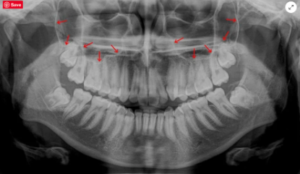CBCT 3D Scans and Dental Implant Sizing to Avoid Complications
Dental Implants
- So lets assume you have all your teeth but are about to replace one due to a fracture, huge cavity, trauma, etc. You would just assume based off of what we just discussed that we place as long and wide of an implant as possible.
- Two common anatomical limitations that limit how long of an implant you can place: Your sinuses and your inferior alveolar nerve.
Maxillary Sinuses
- Maxillary Sinuses: your upper jaw bones have air filled cavities that are connected to your nasal passages.

Upper Jaw Dental Implants
- You want to bury your dental implant as deep as possible in your soft upper jaw bone, but if you have large sinuses, then we’re placing your implant in air because it’s a hollow cavity in your bone. Compare it to trying to secure 3 inches of a screw in the wall but the dry wall is only 1 inch thick.
- Why does this matter? Your implant can fail eventually if your implant isn’t secured in enough bone. Also what if somebody tells you that you need to add more bone in this case via a sinus lift and have to pay thousands of dollars more? You would be able to tell by looking at your CBCT scan (3D Scan)
Lower Jaw Dental Implants
- The inferior alveolar nerve is a major nerve that runs along your lower jaw.
- In the process of trying to place as long of an implant as possible, if your dentist drills into the nerve, you can suffer from permanent numbness of your nerve.
- You will have numbness on the lip and chin area on the affected side.
- We can determine this distance of the nerve by again evaluating your CBCT scan
- We will discuss this more in the implant complications video

